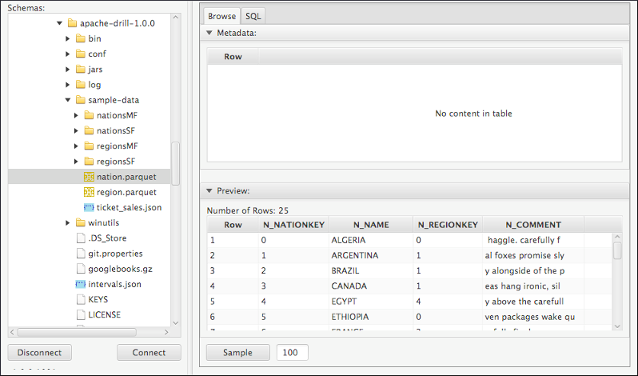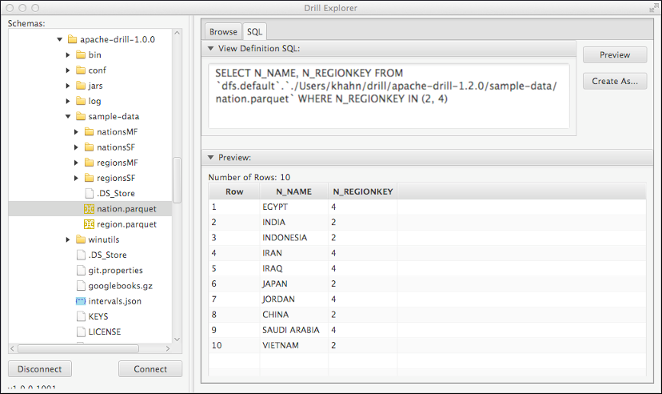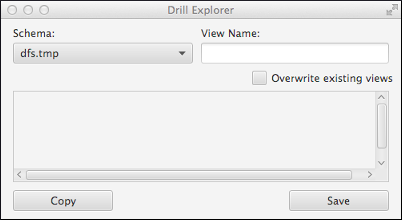Browsing Data and Defining Views
After connecting Drill Explorer to data, the Browse and SQL tabs appear on the right side of the console. On the Browse tab, you view any metadata that might exist for a schema that you access with Drill. On the SQL tab, you preview the results of custom queries and save the results as a view.
Browsing Data
You can browse files and directories if you have permission to read them. In the Schemas pane, you expand branches until you find the file or table you want to view, and then select it.
Tip: To avoid error messages, which you can ignore, expand directories carefully by clicking on the arrow instead of the directory name until you find valid data.
In the Browse tab, the Metadata pane displays the structure, if there is any, of the selected table or file. The Preview pane displays the actual data. The SQL tab displays the statement that returns the data you see in the Browse tab.
To update data after making changes in the data source, right-click a file, table, view, schema, or directory in the Schemas pane, and select Refresh. The scope of the update is limited to the item you right-click.
The following example shows how to browse data using the sample MapR ODBC Driver DSN.
- Start Drill if necessary.
- Start Drill Explorer and connect to the sample DSN.
- In the Schemas pane of Drill Explorer, on the Browse tab, navigate to the
sample-datadirectory in the dfs.default schema. Clicknation.parquet. The data fromnation.parquetappears in the Preview pane.
Defining a View
After browsing data, you can define, preview, and save a view of file-based data. On the SQL tab, modify the statement in View Definition SQL to select the data you want to view. Click Create As to navigate to the location for saving the view. You need to save the view to a location that you define as writable in the storage plugin definition. After saving a view, a message is displayed about the status of the operation. Click Copy to copy the message.
The following example defines and saves a view of a few columns of nation.parquet data.
- Start Drill.
- Start Drill Explorer and connect to the sample DSN.
- In the Schemas section on the Browse tab, navigate to the
/sample-data/nation.parquetin thedfs.defaultschema. -
On the SQL tab, in the View Definition SQL field, enter a query, as described in the Specifying Column Names. For example, modify the SELECT statement as follows:
SELECT N_NAME, N_REGIONKEY FROM `dfs.default`.`./Users/drilluser/drill/sample-data/nation.parquet` WHERE N_REGIONKEY IN (2, 4) Do not put a semicolon at the end of the SQL statement. - Click Preview.

- Click Create As.
The Create As dialog is displayed.

- From the list of schemas, select the schema that defines the location for saving the view. For example, accept the dfs.tmp schema because the default
dfsstorage plugin defines thetmpdirectory as writable. You can save views only to file-based schemas. - In View Name, enter a name for the view. Do not include spaces in the view name.
- Click Save and check Overwrite Existing Views if you want to save over an existing view. The status message associated appears.
- Click Close.
Views that you create using the Drill Explorer do not appear under the schema associated with the data source type. Access the views from the file-based schema that you selected when saving the view.
Specifying Column Names
Use of the SQL asterisk (*) selector to return all columns in a table is limited. Tableau might not connect to your Drill data source successfully using the SQL view that Drill Explorer creates. Modify the queries generated by Drill Explorer to specify columns to return based on the following syntax guidelines, depending on the schema type or file format.
Specify individual columns when defining a view in Drill Explorer instead of attempting to select all, as shown in the following examples.
SELECT CAST(account['name'] AS varchar(20)) FROM hbase.students
SELECT CAST(column1 AS varchar(20)) FROM `dfs`.`default`.`./opt/drill/test.parquet`
SELECT column1 FROM `dfs`.`default`.`./opt/drill/interval.json`
To query nested elements, use the following syntax, where menu is a child of column1:
SELECT column1['menu'] FROM `dfs`.`default`.`./opt/drill/interval.json`
You can query elements that are multiple levels deep. Continuing the example, if menuitem is a child of menu, then use the following syntax:
SELECT column1['menu']['menuitem'] FROM `dfs`.`default`.`./opt/drill/interval.json`
Casting Data Requirements
In SQL statements, you need to cast
binary data to another format explicitly to view the data. For example, the following query
displays results from an HBase database in binary format:
SELECT account['name'] FROM hbase.students
The following query displays the same results in string format:
SELECT CAST(account['name'] AS varchar(20)) FROM hbase.students
The following query displays results from a Parquet file in binary format:
SELECT column1 FROM `dfs`.`default`.`./opt/drill/test.parquet`
The following query displays the same results in string format:
SELECT CAST(column1 AS varchar(20)) FROM `dfs`.`default`.`./opt/drill/test.parquet`
You can also cast the data as other data types, such as integer or date formats.

